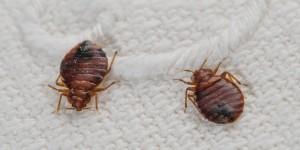How Do U Get Bed Bugs?
Any person, anywhere, can get bed bugs. These crawling insects are just a few millimeters long, their young offspring and eggs even smaller. That makes it very easy for just a few of them to get into your home unnoticed and start reproducing. Feeding of human blood take about five to ten minutes. Each bug feeds on average every three to seven days, so most of the population can stay in hiding most of the time.
How Bed Bugs Travel
Bed bugs can travel several yards to find a host. Sometimes they will crawl through cracks in the walls and pass from one apartment to another. As long as these spaces are as narrow as a credit card the insects can fit their bodies through. There are, however, many other ways they can be transported from an infested location to an area that is not infested.
With their six legs, bed bugs can cling to clothing and hide in shoes. They may be residing in a store or school, or perhaps on the bus or train. Once you get home they get to work and find food sources and places to hide. It may be several months before you even realize the problem, so it’s often very hard to pinpoint when and where you got bed bugs from.
Hotel rooms throughout the world have been infested. That’s why you need to check every piece of furniture and bedding when you arrive. If you know there are bed bugs, then you should leave. Even if you don’t see them, they can hitch a ride in your luggage or bedding. They’re content with staying where they are until you get home. After all, it’s possible to go several weeks without feeding.
Hiding Ability
A bug can hide in the crease of your shirt or in the seams of a bag. At home, their tiny size allows for going unseen and the insects can hide in the corners of drawers, behind wallpaper, and in the tiniest of cracks. They may be under baseboards or under the cushions of your couch. The EPA tells even more about finding bed bugs.
Most of their time is spent hiding. Activity is at a peak between midnight and 5:00am, when human hosts are typically in a deep sleep. They are able to detect carbon dioxide and body heat within three feet. This requires a lot of wandering which is another way they get to travel from one place to another.
If you have bed bugs, you may or may not notice small red swellings on the skin. Unless there’s an allergic reaction or infection, you don’t have to do anything. It often takes several bites before the bug finds a capillary and can rapidly draw blood. Probing the skin may lead to several bites from the same individual in one feeding.
Life Cycle
Adult females, which live about a year, can produce hundreds of eggs. If conditions are right the majority of eggs will hatch within a few days. A bed bug population can double every 16 days because they produce so many eggs. Nymphs, or young bugs, go through their five life stages to adulthood in about 37 days if there are optimal food sources.
Eggs can be laid anywhere. So, wherever you see a bed bug, there might be small hatchlings ready to be born as well. These can be in the loose wall paper, in small cracks, and in drawers and electrical receptacles bed bugs hide.
How do u get bed bugs even with prevention? There are many things you can do to prevent an infestation. Cleanliness is one of them. Regularly dust and vacuum your apartment. Even if there are a few bugs, they will be sucked up. Another way is to check your clothing and luggage for them when traveling. Even look around a hotel room, even if it is a 5-star hotel, to be sure there are no uninvited guests waiting for a ride.
Don’t bring in used furniture from the street. If you are purchasing used items or renting furniture, inspect them carefully. Wash any clothing you suspect of being exposed. By being diligent, it’s harder to get bed bugs, but not impossible.
If you really want to get rid of bed bugs today try SayByeBugs! It was developed as a safe and highly effective alternative among a sea of products that rarely deliver on their promises.
